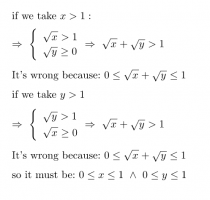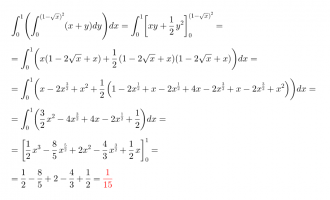You are using an out of date browser. It may not display this or other websites correctly.
You should upgrade or use an alternative browser.
You should upgrade or use an alternative browser.
Double integral -II
- Thread starter canvas
- Start date
BeachBanana
Senior Member
- Joined
- Nov 19, 2021
- Messages
- 2,281
Agreed.if we take x or y greater than 1 then sqrt(x) or sqrt(y) will be greater than 1,
We established that x must be between 0 and 1. So for whatever x-value we pick, y must be "adjusted" to meet the inequality <=1. So it will never exceed 1. For example, x=0 then 0<=y<=1 OR if x=1 then y=0.since sqrt(x) and sqrt(y) are greater or equal than 0 so the sum of sqrt(x)+sqrt(y) will be greater than 1, but it cannot be, right?
You can look at the nice graph that Beach uploaded, or you can test some values for \(\displaystyle x\)."X's limits only range from 0-1."
Can't see that ;/
\(\displaystyle \sqrt{y} \leq 1- \sqrt{x}\)
when \(\displaystyle x = 0\)
\(\displaystyle \sqrt{y} \leq 1\), we are fine.
when when \(\displaystyle x = 1\)
\(\displaystyle \sqrt{y} \leq 0\), we are fine.
when when \(\displaystyle x = 2\)
\(\displaystyle \sqrt{y} \leq 1 - \sqrt{2} \ = \ \)negative, we are not Fine.
So maximum number for \(\displaystyle x\) is \(\displaystyle 1\).
look at #23 there is my explanationYou can look at the nice graph that Beach uploaded, or you can test some values for \(\displaystyle x\).
\(\displaystyle \sqrt{y} \leq 1- \sqrt{x}\)
when \(\displaystyle x = 0\)
\(\displaystyle \sqrt{y} \leq 1\), we are fine.
when when \(\displaystyle x = 1\)
\(\displaystyle \sqrt{y} \leq 0\), we are fine.
when when \(\displaystyle x = 2\)
\(\displaystyle \sqrt{y} \leq 1 - \sqrt{2} \ = \ \)negative, we are not Fine.
So maximum number for \(\displaystyle x\) is \(\displaystyle 1\).
Yeah, nice explanationlook at #23 there is my explanation
I think that you are now good at inequalities as well as double integrals.
Inequality is a tricky subject, so whenever you have questions about it, try to graph or test some values.
For example, \(\displaystyle x^2 + x - 2 \leq 0\). Imagine that you are in a test and you cannot graph this function. What are the range of \(\displaystyle x\) values?
\(\displaystyle ? \leq x \leq \ ?\)
Think about this question, and if you could answer it without seeing the graph, you are ahead of tons of students.
BeachBanana
Senior Member
- Joined
- Nov 19, 2021
- Messages
- 2,281
So what answer did you get?
wOWHere is my attempt, thank you Sir for all the time you spent explaining me these things
View attachment 30791
CorrectWe don't have to graph it it's a quadratic inequality, we know how to solve it easily:
x²+x-2 = x²+2x-x-2 = x(x+2)-(x+2) = (x+2)(x-1)
So (x+2)(x-1) ≤ 0 <=> x ∈ [-2,1]


